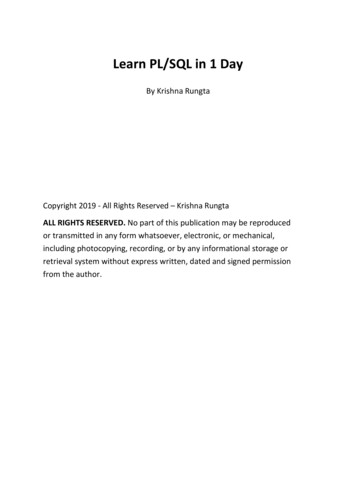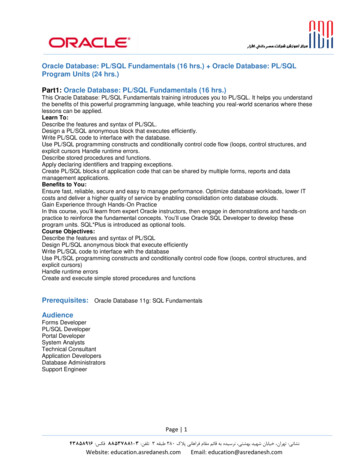
Transcription
DATABASE MANAGEMENT SYSTEM & SQL2 MARK .18.19.20.21.What is a relation? What is the difference between a tuple and an attribute?What is primary key in a table?What is data redundancy? What are the problems associated with it?Define the following terms: (i) Degree (ii) Cardinality.Define first, second and the third normal forms.What are views? How are they useful?Differentiate between Candidate Key and Primary Key in context of RBDMS.Differentiate between Candidate key and Alternate key in context of RDBMS.Differentiate between primary key and alternate key.What are candidate keys in a table? Give a suitable example of candidate keys in a table.Differentiate between Data Definition language and Data Manipulation language.What is the different between WHERE and HAVING clause?Write the SQL statement to create EMPLOYEE relation which contains EMPNO, Name, Skill, PayRate.Create a table with undermentioned structure (Table name is 7,2)CommissionNUMBER(7,2)Create a table with the undermentioned structure (Table name is 2)Create a table called PROJECT with the columns specified BER(2)Create a table called SALGRADE with the columns specified ER(2)Insert a record with suitable data in the table EMP, having system date as the Hiredate.Illustrate Cartesian product operation between the two tables/relations using a suitable example.What is the purpose of key in a table? Give an example of key in a table.Explain the concept UNION between two tables, with the help of appropriate example.
6 MARKS QUESTIONS1. Note: Write SQL commands for (b) to (e) and write the outputs for (f) on the basis of table GRADUATE.Table: 0500400250450500300SUBJECTPHYSICSCOMPUTER MATICSCOMPUTER 112(a) List the names of those students who have obtained DIV 1 sorted by NAME.(b) Display a report, listing NAME, STIPEND, SUBJEZCT and amount of stipend received in ayear assuming that the STIPEND is paid every month.(c) To count the number of students who are either PHYSICS or COMPUTER SC graduates.(d) To insert a new row in the GRADUATE table:11, “KAJOL”, 300, “COMPUTER SC”, 75, 1(e) Give the output of following SQL statement based on table GRADUATE:(I)Select MIN(AVERAGE) from GRADUATE where SUBJECT “PHYSICS”;(II)Select SUM(STIPEND) from GRADUATE where DIV 2;(III) Select AVG(STIPEND) from GRADUATE where AVERAGE 65;(IV) Select COUNT(distinct SUBJECT) from GRADUATE;(f) Assume that there is one more table GUIDE in the database as shown below:Table: GUIDEMAINAREAADVISORPHYSICSVINODCOMPUTER SCALOKCHEMISTRYRAJANMATHEMATICSMAHESHWhat will be the output of the following query:SELECTNAME, ADVISORFROMGRADUATE, GUIDEWHERESUBJECT MAINAREA
2. Write SQL commands for (a) to (d) and write the outputs for (f) on the basis of table CLUB.Table: (a)(b)(c)(d)SEXMFMMMFFFMMTo show all information about the swimming coaches in the club.To list names of all coaches with their date of appointment (DATOFAPP) in descending order.To display a report, showing coachname, pay, age and bonus (15% of pay) for all the coaches.To insert in a new row in the CLUB table with the following data:11, “PRAKASH”, 37, “SQUASH”, {25/02/98}, 2500, “M”(e) Give the output of following SQL statements:(i)Select COUNT(distinct SPORTS) from CLUB:(ii)Select MIN(AGE) from CLUB where SEX “F”;(iii) Select AVG(PAY) from CLUB where SPORTS “KARATE”;(iv)Select SUM(PAY) from CLUB where DATOFAPP {31/01/98};(f) Assume that there is one more table COACHES in the database as shown below:Table: COACHESSPORTSSEXCOACH NOPERSONAJAYM1SEEMAF2VINODM1TANEJAF3What will be the output of the following query:SELECT SPORTSPERSON, COACHNAMEFROMCLUB, COACHESWHERECOACH ID COACH NO
3. (a) Write SQL commands for (i) to (vii) on the basis of the table SPORTSTable: SPORTSStudent No. leticC(i)Display the names of the students who have grade ‘C’ in either Game1 or Game2 or both.(ii)Display the number of students getting grade ‘A’ in Cricket.(iii) Display the names of the students who have same game for both Game1 and Game2.(iv)Display the games taken up by the students, whose name starts with ‘A’.(v)Add a new column named ‘Marks’.(vi)Assign a value 200 Marks for all those who are getting grade ‘B’ or grade ‘A’ in both Game1and Game2.(vii) Arrange the whole table in the alphabetical order of Name.(b)Explain Cartesian product of two relations.4. Given the following Teacher relation: Write SQL commands for question (a) to 001400012000To select all the information of teacher in computer department.To list the name of the female teacher in History department.To list all names of teachers with date of admission in ascending order.To display Teacher’s name, Department, and Salary of female teachers.To count the number of teachers whose salary is less than 10,000.To insert a new record in the Teachers table with the following data:8, “Mersa”, “Computer”, {1/1/2000}, 12000, “M”.(g) Give the output of the following SQL commands:(i) SELECT MIN(DISTINCT Salary) FROM Teacher(ii) SELECT MIN(Salary) FROM Teacher WHERE Sex “M”(iii) SELECT SUM(Salary) FROM Teacher WHERE Department “History”(iv) SELECT ACG(Salary) FROM Teacher WHERE dateofjoining {1/1/98}.SexMFFMMMF
5. Given the following tables for a database INTERIORS :Note: Write SQL command for (a) to (f) and write the outputs for (g) on the basis of tables INTERIORSand NEWONES.Table: ed roseDouble bed23/02/0232000152Soft touchBaby cot20/01/029000103Jerry’s homeBaby cot19/02/028500104Rough woodOffice Table01/01/0220000205Comfort zoneDouble bed12/01/0215000206Jerry lookBaby cot24/02/027000197Lion kingOffice Table20/02/0216000208Royal tigerSofa22/02/0230000259Park sittingSofa13/12/0190001510Dine ParadiseDining Table19/02/021100015NO.111213ITEMNAMEWhite woodJames 007Tom lookTable: NEWONESTYPEDATEOFSTOCKSDouble bed23/03/03Sofa20/02/03Baby cot21/02/13PRICE20000150007000DISCOUNT201510(a) To show all information about the sofas from the INTERIORS table.(b) To list the ITEMNAME which are priced at more than 10,000 from the INTERIORStable.(c) To list ITEMNAME and TYPE of those items, in which DATEOFSTOCK is before 22/01/02from the INTERIERS table in the descending order of ITEMNAME.(d) To display ITEMNAME and DATEOFSTOCK of those items, in which the discount percentageis more than 15 from INTERIORS table.(e) To count the number of items, whose type is “Double Bed” from INTERIORtable.(f) To insert a new row in the NEWONES table with the following data:14, “True Indian”, “Office Table”,{28/03/03}, 15000,20(g) Give the output of following SQL statement:Note: outputs of the below mentioned queries should be based in original data given in both the tablesi.e., without considering the insertion done in (f) part of this question.(i)Select COUNT(distinct TYPE) from INTERIORS;(ii)Select AVG(DISCOUNT) from INTERIORS, where TYPE “Baby cot”,(iii) Select SUM(Price) from INTERIORS where DATEOFSTOCK {12/02/02}.
6. Given the following tables for a database FURNITURE :NOTE: Write SQL command for (a) to (f) and write the outputs for (g) on the bases of tablesFURNITURE AND ARRIVALS.Table: FURNITURENO.12345678910ITEMNAMEWhite lotusPink featherDolphinDecentComfort zoneDonaldRoyal FinishRoyal tigerEcono sittingEating paradiseTable: ARRIVALSNO.ITEMNAME11Wood Comfort12Old Fox13MickyTYPEDouble BedBaby cotBaby cotOffice TableDouble BedBaby cotOffice TableSofaSofaDining TableTYPEDouble BedSofaBaby DISCOUNT25202030251530302525DISCOUNT252015(a) To show all information about the baby cots from the FURNITURE table.(b) To list the ITEMNAME which are priced at more than 15000 from the FURNITURE table.(c) To list ITEMNAME AND TYPE of those items, in which DATEOFSTOCK is before 22/01/02from the FURNITURE table in descending order of ITEMNAME.(d) To display ITEMNAME and DATEOFSTOCK of those items, in which the DISCOUNTpercentage is more than 25 from FURNITURE table.(e) To count the number of items, whose TYPE is “Sofa” from FURNITURE table.(f) To insert a new row in the ARRIVALS table with the following data:14, “Velvet touch”, Double bed”, {25/03/03}, 25000, 30(g) Give the output of following SQL statement:Note:outputs of the below mentioned queries should be based on original data given in both thetables i.e., without considering the insertion done in (g) part of this question.(i)Select COUNT(distinct TYPE) from FURNITURE;(ii)Select MAX(DISCOUNT) from FURNITURE,ARRIVALS;(iii)Select AVG(DISCOUNT) from FURNITURE where TYPE “Baby cot”;(iv) Select SUM(PRICE) from FURNITURE where DATEOFSTOCK {12/02/02}.
7. Given the following tables for a database LIBERARY:Table: BooksBook Id Book Name Author Name PublishersF0001The TearsWilliamFirst Publ.HopkinsF0002ThunderboltsAnna RobertsFirst Publ.T0001My First C Brian & BrookeEPBT0002C A.W.RossaineTDHBrainworksC0001Fast 5FictionTextText5105350Cookery8Table: IssuedBook IdF0001T0001C0001Quantity Issued315Write SQL queries for (a) to (f):(a) To show Book name, Author name and Price of books of EPB publishers.(b) To list the names of the books of Fiction Type.(c) To display the names and price of the books in descending order of their price.(d) To increase the price of all books of first publisher by 50.(e) To display the Book Id, Book Name and Quantity issued for all books which have been issued.(The query will require contents from both the tables).(f) To insert a new row in the table Issued following the data: “F0002”,4(g) Give the output of the following queries based on the above tables:(i) SELECT COUNT(DISTINCT Publishers) FROM Books.(ii) SELECT SUM(Price) FROM Books WHERE Quantity 5.(iii) SELECT BOOK NAME,AUTHOR NAME FROM Books WHERE Price 500.(iv) SELECT COUNT (*) FROM Books.8. Write SQL commands for (a) to (f) and write output for (g) on the basis of Teacher relation given below:relation TeacherNo.NameAgeDepartmentDate of .Shiv 720000F(a)(b)(c)(d)(e)(f)To show all information about the teacher of history departmentTo list the names of female teacher who are in Hindi departmentTo list names of all teachers with their date of joining in ascending order.To display student’s Name, Fee, Age for male teacher onlyTo count the number of teachers with Age 23.To inset a new row in the TEACHER table with the following data:9, “Raja”, 26, “Computer”, {13/05/95}, 2300, “M”
(g) Give the output of following SQL statements:(i) Select COUNT (distinct department) from TEACHER;(II) Select MAX (Age) from TEACHER where Sex “F”(iii) Select AVG (Salary) from TEACHER where Date of join {12/07/96};(iv) Select SUM (Salary) from TEACHER where Date of join {12/07/96};9. Write SQL commands for (a) to (f) and Write the outputs for (g) on the basis of table HOSPITALTable: a23Nuclear Medicine21/02/98400F(a)(b)(c)(d)(e)(f)To select all the information of patients of cardiology department.To list the names of female patients who are in ENT department.To list name of all patients with their date of admission in ascending order.To display Patient’s Name, Charges, Age for only female patients.To count the number of patients with Age 30.To inset in a new row in the HOSPITAL table with the following data:11, “Aftab”, 24, “Surgery”, {25/02/98}, 300, “M”(g) Give the output of following SQL statements:(i) Select COUNT (DISTINCT charges) from HOSPITAL;(ii) Select MIN (Age) from HOSPITAL where Sex “F”(iii) Select SUM (Charges) from HOSPITAL where Department “ENT”(iv) Select AVG (Charges) from HOSPITAL where Datofadm {12/08/98}10. Answer the questions (a) and (b) on the basis of the following tables STORE and ITEM.TABLE STORESNoSNameAreaS01ABC ComputronicsGK IIS02All Infotech MediaCPS03Tech ShoppeNehru PlaceS04Geeks Techno SoftNehru PlaceS05Hitech Tech StoreCPINoT01T02T03T04T05T06T07T08T09T10TABLE ITEMINamePriceMother Board12000Hard Disk5000Keyboard500Mouse300Mother Board13000Keyboard400LCD6000LCD5500Mouse350Hard Disk4500SNoS01S01S02S01S02S03S04S05S05S03
(a)(b)Write the SQL queries (i) to (iv):(i) To display IName and Price of all the items in ascending order of their Price.(ii) To display SNo and SName of all store location in CP.(iii) To display Minimum and maximum Price of each IName from the table ITEM.(iv) To display IName, Price of all items and their respective SName where they areavailable.Write the output of the following SQL commands (i) to (iv):(i) SELECT DISTINCT IName FROM ITEMWHERE Price 5000;(ii) SELECT Area, COUNT (*)FROM STORE GROUP BY Area;(iii) SELECT COUNT (DISTINCT Area)FROM STORE:(iv) SELECT IName, Price * 0.05DISCOUNT FROM ITEMWHERE SNo IN (‘S02’, ‘S03’);11. Answer the questions (a) and (b) on the basis of the following tables SHOPPE and ACCESSORIES.TABLE SHOPIDSNameS0001ABC ComputeronicsS0002All Infotech MediaS0003Tech ShoppeS0004Greeks Techno SoftS0005Hitech Tech StoreNoA01A02A03A04A05A06A07T08T09T10AreaCPGK IICPNehru PlaceNehru PlaceTABLE ACCESSORIESNamePriceIDMother Board12000Hard Disk5000Keyboard500Mouse300Mother Board13000Keyboard400LCD6000LCD5500Mouse350Hard Disk4500S01S01S02S01S02S03S04S05S05S03(a) Write the SQL queries:(i)To display Name and Price of all the accessories in ascending order of their Price.(ii)To display Id and SName of all Shoppe in Nehru Place.(iii)To display Minimum and Maximum Price of each Name of accessories.(iv)To display Name, Price of all accessories and their respective SName where they areavailable.(b) (i)SELECT DISTINCT Name FROM ACCESSORIES WHERE Price 500;(ii)SELECT Area, COUNT (*) FROM GROUP BY Area;(iii)SELECT COUNT (DISTINCT Area) FROM SHOPPE;(iv)SELECT Name, Price*0.05 DISCOUNT FROM ACCESSORIES WHERE SNo IN (‘S02,‘S03’);
12. Write SQL queries for (a) to (f) and write the outputs for the SQL queries mentioned shown in (g1) to (g4)parts on the basis of tables PRODUCTS AND SUPPLIERSTABLE PRODUCTSPIDSNAMEQTY PRICECOMPANYSUPCODE101DIGITAL CAMERA14X12012000RENIXS01102DIGITAL PAD lli10022000DIGI POPS02104PEN DRIVE 16 GB 5001100STOREKINGS01106LED SCREEN7028000DISEXPERTSS02105CAR GPS SYSSTEM 6012000MOVEONS03SUPCODES01S03S02TABLE SUPPLIERSSNAMECITYGET ALL INCKOLKATAEASY MARKET CORPDELHIDIGI BUSY GROUP CHENNAI(a) To display the details of all the products in ascending order of product names (i.e. PNAME).(b) To display product name and price of all those products, whose price is in the range of 10000 and15000 (both values inclusive).(c) To display the number of products which are supplied by each supplier i.e. the expected outputshould beS012S022S031(d) To display the price, product name (i.e. PName) and quantity (i.e. QTY) of those which havequantity more than 100.(e) To display the names of those suppliers, who are either from DELHI or from CHENNAI.(f) To display the name of the companies and the name of the products in descending order ofcompany names.(g) Obtain the outputs of the following SQL queries based on the data given in tables PRODUCTSand SUPPLIERS.(g1)SELECT DISTINCT SUPCODE FROM PRODUCTS;(g2)SELECT MAX(PRICE), MIN (PRICE) FROM PRODUCTS;(g3)SELECT PRICE * QTY AMOUNT FROM PRODUCTS WHERE PID 104;(g4)SELECT PNAME, SNAME FROM PRODUCTS P, SUPPLIERS SWHERE P. SUPCODE S. SUPCODE AND QTY 100;
13. Write SQL queries for (a) to (f) and write the outputs for the SQL queries mentioned shown in (g1) to (g4)parts on the basis of tables ITEMS and TRADERS.TABLE ITEMSCODEINAMEQTYPRICECOMPANYTCODE1001DIGITAL PAD12i 12011000XENITAT011006LED SCREEN 407038000SANTORAT021004CAR GPS SYSTEM5021500GEOKNOWT011003DIGITAL CAMERA 12X1608000DIGICLICKT021005PEN DRIVE 32 GB6001200STOREHOMET03TCODET01T03T02TABLE TRADERSTNAMECITYELECTRONIC SALESMUMBAIBUSY STORE CORPDELHIDISP HOUSE INCCHENNAI(a) To display the details of all the items in ascending order of item names (i.e. INAME).(b) To display item name and price of all those items, whose price is in the range of 10000 and 22000(both values inclusive).(c) To display the number of items, which are traded by each trader. The expected output of thisquery should beT01 2T02 2T03 1(d) To display the price, item name (i.e. INAME) and quantity (i.e. QTY) of those items which havequantity more than 150.(e) To display the names of those traders, who are either from DELHI or from MUMBAI.(f) To display the name of the companies and the bane of the items in descending order of companynames.(g) Obtain the outputs of the following SQL queries based on the data given in tables ITEMS andTRADERS.(g1) SELECT MAX (PRICE), MIN (PRICE) FROM ITEMS;(g2) SELECT PRICE * QTY AMOUNT FROM ITEMS WHERE CODE 1004;(g3) SELE CT DISTINCT TCODE FROM ITEMS;(g4) SELECT INAME, TNAME FROM ITEMS I, TRASERS TWHERE I, TCODE AND QTY 100;
14. Write SQL queries for (a) to (f) and write the outputs for the SQL queries mentioned shown in (g1) to (g4)parts on the basis of tables APPLICANTS and COURSES.TABLE APPLICANTSNONAMEFEEGENDERC ID 000MA0420111101Kirat25000MA012012C IDA01A02A03A04A05(a)(b)(c)(d)TABLE COURSESCOURSEFASHION DESIGNNETWORKINGHOTEL MANAGEMENTEVENT MANAGEMENTOFFICE MANAGEMENTTo display name, fee, gender, joinyear about the applicants, who have joined before 2010.To display the names of applicants, who are paying fee more than 30000.To display name of all applicants in ascending order of their joinyear.To display the year and the total number of applicants joined in each YEAR from the tableAPPLICANTS.(e) To display the C ID (i.e. Course ID) and the number of applicants registered in the course fromthe APPLICANTS table.(f) To display the applicant’s name with their respective course’s name from the tablesAPPLICANTS and COURSES.(g) Give the output of following SQL statements:(g1) SELECT NAME, JOIN YEAR FROM APPLICANTS WHERE GENDER ‘F’ ANDC ID ‘02’;(g2) SELECT MIN(JOINYEAR) FROM APPLICANTS WHERE Gender ‘M’;(g3) SELE CT AVG(FEE) FROM APPLICANTS WHERE C ID ‘A01’ OR C ID ‘A05’;(g4) SELECT SUM (FEE), C ID FROM APPLICATIONS GROUP BY C ID HAVINGCOUNT (*) 2;
15. Consider the following tables CABHUB and CUSTOMER and answer (a) and (b) parts of this question:TABLE aSILVER312Code1234TABLE CUSTOMERCNameVCodeHemantSahu101Raj Lal108Feroza Shah105Ketan Dhal104(a) Write SQL commands for the following statements:(i) To display the names of all the white colored vehicles.(ii) To display name of vehicle, make the capacity of vehicles in ascending order of their sittingCapacity.(iii) To display the highest charges at which a vehicle can be hired from CABHUB.(iv) To display the customer and the corresponding name of the vehicle hired by them.(b) (i) SELECT COUNT (DISTINCT Make) FROM CABHUB;(ii) SELECT MAX (CHARGES), MIN (Charges) FROM CABHUB;(iii) SELECT COUNT(*), Make FROM CABHUB;(iv) SELECT VehicleName FROM CABHUB WHERE Capacity 4;16. Consider the following tables CARDEN and CUSTOMER and answer (a) and (b) parts of this question:TABLE 435TABLE CUSTOMERCCodeCnameCcode1001HamantSahu5011002Raj Lal5091003Feroja Shah5031004Ketan Dhal502(a) Write SQL commands for the following statements:(i) To display the name of all the SILVER colored cars.(ii) To display name of car, make and capacity of cars in descending order of their sittingcapacity.(iii) To display the highest Charges at which a vehicle can be hired from CARDEN.(iv) To display the customer name and the corresponding name of the cards hired by them.(b) Give the output of the following SQL queries:(i) SELECT COUNT (DISTINCT Make) FROM CARDEN;(ii) SELECT MAX (Charges), MIN (Charges) FROM CARDEN;(iii) SELECT COUNT (*), Make FROM CARDEN;
(iv) SELECT CarName FROM CARDEN WHERE Capacity 4;17. Consider the following tables EMPLOYEE and SALGRADE and answer (a) and (b) parts of this question:TABLE EMPLOYEEECODENAMEDESIGSGRADEDOJDOB101Abdul AhmadEXECUTIVE S0323-MARCH-200313-JAN-1980102Ravi ChanderHEAD-ITS0212-FEB-201022-JUL-1987103John KenReceptionist -1982TABLE 03240008000(a) Write SQL commands for the following statements:(i) To display the detail of all the EMPLOYEE in descending order of DOJ.(ii) To display name and design of those EMPLOYEE, whose sgrade is either S02 or S03.(iii) To display the content of all the EMPLOYEE table, whose DOJ is in between ’09-FEB2006’and ’08-AUG-2009’.(iv) TO add a new row in the EMPLOYEE table with the following data:109, ‘Harish Roy’, ‘HEAD-IT’, ‘S02’, ’09-SEP-2007’, ’21-APR-1983’.(b) Give the output of the following SQL queries:(i) SELECT COUNT (SGRADE), SGRADE FROM EMPLOYEE GROUP BY SGRADE;(ii) SELECT MIN (DOB), MAX (DOJ) FROM EMPLOYEE;(iii) SELECT NAME, SALARY FROM EMPLOYEE E, SALGRADE SWHERE E. SGRADE S. SGRADE AND E. ECODE 103;(iv) SELECT SGRADE, SALARY HRA FROM SALGRADE WHERE SGRADE ‘S02’;18. Consider the following tables WORKER and PAYLAVEL and answer (a) and (b) parts of this thFizzaAhmeen AhmadSanyaPLEVELP001P002P003TABLE UL-198714-OCT-198313-MAR-198409-JUN-1983TABLE PAYLEVELPAY ALLOWANCE26000120002200010000120006000(a) Write SQL commands for the following statements:(i) To display the detail of all WORKER in descending order of DOB.(ii) To display name and design of those WORKER, whoseplevel is either P001 to P002.
(iii) To display the content of all the WORKER table, whose DOB is in between ‘19-JAN-1984’and ‘18-JAN-1987’.(iv) To add a new row with the following:19, ‘Daya Kishore’, ‘Operator’, ‘P003’, ’19-JUN-2008’, ’11-JUL-1984’.(b) Give the output of the following SQL queries:(i) SELECT COUNT (PLEVEL), PLEVEL FROM WORKER GROUP BY PLEVEL;(ii) SELECT MAX (DOB), MIN (DOJ) FROM WORKER;(iii) SELECT NAME, PAY FROM WORKER W, PAYLEVEL PWHERE W. PLEVEL P.LEVEL AND W. ECODE 13;(iv) SELECT PLEVEL, PAY ALLOWANCE FROM PLEVEL WHERE PLEVEL ‘P003’;19. Consider the following tables STORE and SUPPLIERS and answer (a) and (b) parts of this question:TABLE STOREiteemNoItemScodeQtyRateLastBuy2005Sharpener Classic2360831-JUN-092003Ball pen 0.2522502501-FEB-092002Gel Pen Premium211501224-FEB-102006Gel Pen Classic212502011-MAY-092001Eraser Small22220619-JAN-092004Eraser Big22110802-DEC-092009Ball Pen 0.5211801803-NOV-09Scode212322TABLE SUPPLIERSSnamePremium StationersSoft PlasticsTetra Supply(a) Write SQL commands for the following statements:(i) To display details of all the items in the Store table in ascending order of LastBuy.(ii) To display ItemNo and Item name of those items from STORE table whose Rate is morethan15 Rupees.(iii)To display the details of those items whose Supplier code (Scode) is 22 or Quantity inStore (Qty) is more than 110 from the table STORE.(iv)To display minimum Rate of items for each supplier individually as per Scode from the tableSTORE.(b) Give the output of the following SQL queries:(i) SELECT COUNT (DISTINCT Scode) FROM STORE;(ii)SELECT Rate * Qty FROM STORE WHERE ItemNo 2004;(iii)SELECT Item,Sname FROM Store S, SUPPLIERS PWHERE S.Scode P.ScodeAND ItemNo 2006;(iv) SELECT MAX(LastBuy) FROM STORE;
20. Consider the following table GARMENT and FABRIC, Write SQL commands for the statements (i) to (iv) and giveoutputs for the SQL queries (v) to 071002010089TABLE GARMENTDESCRIPTIONPRICEPENCIL SKIRT1150FORMAL SHIRT1250INFORMAL SHIRT1550BABY TOP750TULIP SKIRT850EVENING GOWN850INFORMAL PANT1500FORMAL PANT1350FROCK850SLACKS750FCODEF 03F 01F 02F 03F 02F 03F 02F 01F 04F 8TABLE FABRICFCODETYPEF 04POLYSTERF 02COTTONF 03SILKF01TERELENE(i) To display GCODE and DESCRIPTION of each GARMENT in descending order of GCODE.(ii) To display the details of all the GARMENT, which have READYDATE in between 08-DEC-07 and16-JUN-08 (inclusive if both the dates).(iii) To display the average PRICE of all the GARMENT, which are made up of fabric with FCODE asF03.(iv) To display fabric wise highest and lowest price of GARMENT from GARMENT table. (DisplayFCODE of each GARMENT along with highest and lowest Price).(v) SELECT SUM (PRICE) FROM GARMENT WHERE FCODE ‘F01’;(vi) SELECT DESCRIPTION, TYPE FROM GARMENT, FABRICWHERE GARMENT, FCODE FABRIC.FCODE AND GARMENT.PRICE 1260;(vii) SELECT MAX (FCODE) FROM FABRIC;(viii) SELECT COUNT (DISTINCT PRICE) FROM GARMENT;
DATABASE MANAGEMENT SYSTEM & SQL2 MARK QUESTIONS1.A relation is table having atomic values, unique rows and unordered rows and columns.A row in a relation is known as tuple whereas a column of a table is known as an attribute.2.A Primary Key is a set of one or more attributes that can be uniquely identify tuples within therelation.3.Duplication of data is data redundancy. It leads to the problems like wastage of space and datainconsistency.4.(i) Degree: The numbers of attributes (columns) in a relation determine the degree of a relation.(ii) Cardinality: The number of tuples (rows) in a relation is called the cardinality of the relation.5.A relation R is in first normal form (INF) if and only if all underlying domains of the relationcontain atomic (indivisible) values.A relation R is in second normal form (2NF) if and only if it is in 1 NF and every nonkey attributeis fully dependent on the primary key.A relation R is said to be in third normal form (3NF) if only and if it is in 2 NF and every nonkeyattribute is non-transitively dependent upon the primary key.6.A view is a virtual table that does not really exist in its own right but it instead derived from oneand more underlying base table(s). The view is kind of table whose contents are taken upon othertables depending upon a given query condition. No stored file is created to store contents of aview rather its definition is stored only.The usefulness of views lies in the fact that they provide an excellent way to give people access tosome but not all of the information in a table.7.Candidate Key. A candidate key is the one that is capable of becoming primary key. i.e., a fieldor attribute that has unique value for each row in the relation.Primary Key is a designed attribute or a group of attributes whose values can uniquely identifythe tuples in the relation.8.Candidate Key. A candidate key is the one that is capable of becoming primary key i.e., a field orattribute that has unique value for each row in the relation.A candidate key that is not a primary key is called an Alternate key.9.Primary Key. It is the set of one or more attributes that can uniquely identify tuples within arelation.Alternate Key. It is a candidate key which is not primary key.10.A candidate key is the one that is capable of becoming primary key i., a field or attribute that hasunique value for each row in the relation.Example Table: DVD200110Floppy400{Candidate Keys}11.The SQL DDL provides commands for defining relation schemas, deleting relationship, creatingindexes and modifying schemas.The SQL DML includes a query language to insert, delete and modify tuples in the database.Data Manipulation Language (DML) is used to put values and manipulate them in tables andotherdatabase objects and Data Definition language (DDL) is used to create tables and other databaseobjects.12.The HAVING clause places conditions on groups in contrast to WHERE clause, which placesconditions on individual rows.
13.14.15.16.17.18.19.CREATE TABLE Employee(EmpNoCHAR(4) NOT NULL PRIMARY KEY,NameCHAR(20) NOT NULL,SkillCHAR(1),PayRat
Differentiate between Data Definition language and Data Manipulation language. 12. What is the different between WHERE and HAVING clause? 13. Write the SQL statement to create EMPLOYEE relation which contains EMPNO, Name, Skill, PayRate. . 9 Econo sitting Sofa 13/12/01 9500 25 10 Eating paradise Dining Table 19/02/02 11500 25 Table: ARRIVALS .











